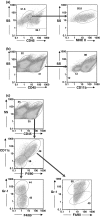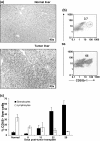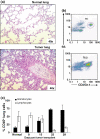The mouse mammary carcinoma 4T1: characterization of the cellular landscape of primary tumours and metastatic tumour foci
- PMID: 17877537
- PMCID: PMC2517332
- DOI: 10.1111/j.1365-2613.2007.00539.x
The mouse mammary carcinoma 4T1: characterization of the cellular landscape of primary tumours and metastatic tumour foci
Abstract
The murine mammary carcinoma 4T1 causes a leukemoid reaction with profound granulocytosis coincident with the production of tumour-derived growth factors. Here, we study the evolving cellular landscape of primary tumours and metastatic tumour foci and correlate haematopoietic cell infiltration with the production of tumour-derived chemokines. Flow cytometric analysis of enzyme digested primary tumours at different times after transplantation revealed a progressively increasing CD45(+) haematopoietic cell infiltrate consisting predominantly of CD11b(+) myeloid cells. Most of these cells had an F4/80(+)/CD11c(+) phenotype, many of which also stained Gr-1(+). Smaller numbers of Gr-1(+)CD11b(+) granulocytes and lymphoid cells were also identified. Progressive increases in Gr-1(+) granulocytes were observed in enzymatic digests of livers and lungs with metastatic tumour foci. Cultured 4T1 tumour cells expressed mRNA transcripts for the myeloid cell chemokines RANTES, MCP-1 and KC, and enzymatically digested cells from primary 4T1 tumours partially depleted of CD45(+) cells expressed transcripts for these chemokines and also MIP-1alpha and MIP-1beta. These data demonstrate that 4T1 tumour-bearing mice have mixed myeloid cell infiltrates of primary tumours and granulocytic infiltrates of metastatic organs. This pathologic presentation correlated with the expression of tumour-derived chemokines.
Figures





References
-
- Adler EP, Lemken CA, Katchen NS, Kurt RA. A dual role for tumor-derived chemokine RANTES (CCL5) Immunol. Lett. 2003;90:187–194. - PubMed
-
- Aeed PA, Nakajima M, Welch DR. The role of polymorphonuclear leukocytes (PMN) on the growth and metastatic potential of 13762NF mammary adenocarcinoma cells. Int. J. Cancer. 1988;42:748–759. - PubMed
-
- Almand B, Clark JI, Nikitina E, et al. Increased production of immature myeloid cells in cancer patients: a mechanism of immunosuppression in cancer. J. Immunol. 2001;166:678–689. - PubMed
-
- Angulo I, de las Heras FG, Garcia-Bustos JF, Gargallo D, Munoz-Fernandez MA, Fresno M. Nitric oxide-producing CD11b(+)Ly-6G(Gr-1)(+)CD31(ER-MP12)(+) cells in the spleen of cyclophosphamide-treated mice: implications for T-cell responses in immunosuppressed mice. Blood. 2000;95:212–220. - PubMed
-
- Aslakson CJ, Miller FR. Selective events in the metastatic process defined by analysis of the sequential dissemination of subpopulations of a mouse mammary tumor. Cancer Res. 1992;52:1399–1405. - PubMed
Publication types
MeSH terms
Substances
Grants and funding
LinkOut - more resources
Full Text Sources
Other Literature Sources
Medical
Research Materials
Miscellaneous

